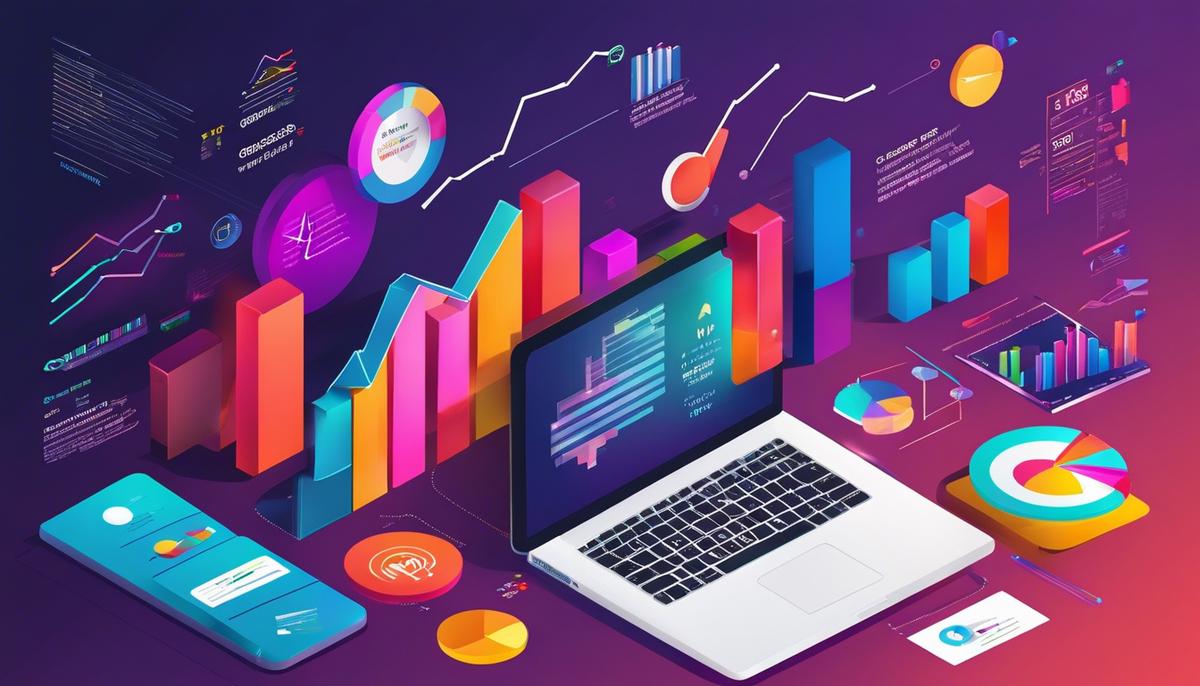
As the digital landscape continues to evolve at a breakneck pace, the world of marketing has been turned on its head, opening up new frontiers that businesses are eager to explore. With the advent of sophisticated technologies such as artificial intelligence and machine learning, marketers are now able to automate and optimize their campaigns like never before. This essay embarks on a journey to unveil the latest digital marketing trends, digging deep into the transformative effects of voice search, interactive content, and the quest for personalization at scale. We will navigate the intricate realms of data-driven marketing, examining how analytics shape our strategies while keeping a keen eye on ethical and privacy standards. Furthermore, we delve into the dynamic arenas of social media and influencer marketing, omni-channel presence, and conversion rate optimization—each element contributing to the complex mosaic of modern digital marketing.
Trends in Digital Marketing
Emerging Tech Trends Reshaping Digital Marketing
In the rapidly evolving world of digital marketing, cutting-edge technology trends hold the reins to transformation. Staying ahead of these trends isn’t just a matter of industry speak; it’s the key to giving brands a competitive edge and enhancing user engagement.
One significant stride in the field is the application of artificial intelligence (AI). AI is elevating personalized marketing to new heights, with machine learning algorithms crunching data in real-time, tailoring content, recommendations, and advertisements to individual consumer behaviors. Platforms like Google Ads now offer AI-driven predictions and insights, helping marketers optimize campaigns for higher conversion rates.
Another piece of the tech puzzle is big data analytics. An ocean of data from social media, purchase histories, and online interactions is at marketers’ fingertips. By leveraging this vast repository, digital marketing campaigns are becoming more targeted and efficient, resulting in increased ROI and reduced ad spend wastage.
The proliferation of voice search through assistants such as Siri and Alexa introduces a new frontier for SEO strategies. Companies are refocusing their content to align with conversational queries, anticipating the natural language patterns of voice searches. This shift underscores the need for marketers to think audibly and contextually to capture this growing segment.
Augmented reality (AR) is revolutionizing customer experiences, allowing brands to present interactive and immersive content. AR enables consumers to visualize products in their own environment before purchasing, thereby strengthening purchasing confidence and boosting engagement levels.
Blockchain technology is on a quest to build trust in this digital era. It introduces transparency in ad delivery by authenticating that ads reach real humans, not bots. Use cases extend to preventing ad fraud and improving data security, making blockchain a potential backbone for ethical digital marketing.
Last but not least, chatbots have become a mainstay, offering round-the-clock customer service. These AI-powered conversational agents provide instant responses to queries, ensuring customer interactions are seamless and information dissemination is consistent.
To sum up, emerging tech trends are redefining digital marketing by enabling hyper-personalized and efficient campaigns, pioneering new ways to interact with content, and building trust through transparency and security. In this tech-savvy landscape, agility in adopting new technologies is paramount for digital marketers aiming to stay relevant and capture the ever-shifting attention of consumers.

Data-Driven Marketing
Harnessing the Power of Data in Digital Marketing
In an era where digital footprints grow larger by the day, data has become the lifeline of effective digital marketing strategies. Data’s ability to transform how businesses reach, engage, and retain customers can’t be overstated—analyzing consumer behavior, preferences, and interactions has revolutionized marketing’s fundamental approaches.
At the outset, data provides unprecedented insights into customer demographics. Marketers can now craft campaigns that resonate with specific audience segments, thanks to granular data that details age, location, gender, and even income levels. This precision ensures that messages are not only reached but also resonate with the intended audience, increasing the likelihood of conversion.
Engagement patterns and purchase histories further refine marketing efforts, as businesses can carefully track which products or services attract more attention. By sifting through this information, digital marketing strategies are crafted with a precision that was once impossible. Retargeting efforts, for instance, become sharply effective, delivering personalized content likely to trigger repeat purchases or re-engage cold leads.
Moreover, real-time data analytics empowers marketers to make swift decisions in response to emerging trends and customer feedback. Sentiment analysis, for instance, allows companies to gauge public reaction to a new product launch or an advertising campaign, enabling quick course corrections if necessary.
Data is also a key player in understanding customer lifetime value (CLV), critical to shaping long-term strategy. By predicting the profit a business can expect from a long-term relationship with a customer, data guides where to allocate resources for retention and loyalty programming.
Additionally, A/B testing is a vital tool underpinned by data. Marketers can trial different versions of website layouts, email campaigns, or even social media ads to ascertain which variant yields the best outcomes. This scientific approach to marketing is data-centric, basing conclusions on measurable results rather than assumptions.
In the realm of competition analysis, data levels the playing field. Businesses of any size can now access tools to monitor competitors’ digital tactics, learn from their performance, and identify gaps in the market. This intelligence informs strategy, enabling businesses to exploit opportunities or strengthen weaknesses.
Lastly, as privacy concerns escalate and regulations such as GDPR take hold, data integrity becomes paramount. Ethically sourced and properly managed data isn’t just a legal mandate; it fosters trust between consumers and companies. A brand seen as a custodian of personal information earns the kind of loyalty that today’s discerning customer reserves for transparent and responsible businesses.
Conclusively, the ubiquity of data in digital marketing is a call to action for businesses to embrace advanced analytical tools and methodologies. Data is not merely a resource; it is the strategic axis around which modern marketing orbits, indispensable in designing campaigns that are personal, engaging, and ultimately, highly effective in a fiercely competitive digital landscape.

Social Media and Influencer Marketing
The Subtle Shift From Influence to Authenticity in Social Media Marketing
In the realm of social media, the buzz around influencer marketing remains deafening, yet the approach is undergoing a significant metamorphosis. The push is moving away from mere popularity towards authentic content that resonates on a personal level with target audiences. Here’s a look at the current pivot that’s setting the stage for the future of influencer marketing within the social media landscape.
Content Creators Take Center Stage
The influencer tide is turning, with a distinct rise in content creators who are subject matter experts rather than mere trend emulators. These individuals bring substantive, specialized knowledge to the proverbial table. Whether it’s a tech-savvy reviewer demystifying the latest smartphone or a fashion-forward blogger with practical styling tips, their authority and genuine connection with followers wield more conversion power than traditional celebrity endorsements.
Micro-Influencers and Niche Marketing
Fueled by the quest for authenticity, brands are increasingly partnering with micro-influencers. These smaller-scale social media personalities often boast highly engaged audiences in niche markets. The rationale is simple yet powerful: a smaller follower count often means higher interaction rates, providing a fertile ground for brands to sow seeds of trust. This focus on niche marketing amplifies the relevance of the message, making the promotion feel less like an ad and more like valuable, tailored advice.
Interactive Platforms and Shoppable Posts
The seamless integration of shopping experiences into social media is spotlighting platforms that support interactive and shoppable content. By leveraging features such as Instagram’s shoppable posts and TikTok’s integrated shopping, influencer marketing monetizes content in real-time, capitalizing on impulse buying behaviors and reducing the distance between discovery and purchase.
The Ethical Facet
As consumers become savvier, there’s a surging expectation for transparency in influencer partnerships. Sponsorship disclosures are not just legally mandated; they’re a badge of ethical marketing. Influencers who are upfront about collaborations garner trust and respect, and the content they produce is consumed with an understanding of the sponsorship context, mitigating potential backlash against perceived deceit.
Collaborative Storytelling
Storytelling has always been at the heart of compelling marketing, and it’s no different in the age of influencers. However, the narrative is shifting towards collaboration, with creators and brands coining stories that interweave product messages with real-life scenarios. The result is a more immersive and relatable experience that invokes a shared journey rather than a one-sided sales pitch.
The Impact of Platform Alchemy
As social media platforms evolve and new ones emerge, influencers must adapt to the unique language and audience of each forum. The alchemy of platform-specific content that aligns engagement strategies – be it the fleeting snaps of Snapchat, the curated visuals of Pinterest, or the live broadcasts of Twitch – is non-negotiable. This dynamic becomes a test of versatility and adaptability for influencers and the brands that engage with them.
In conclusion, influencer marketing is adopting a more sophisticated, nuanced form, encapsulating authenticity, expertise, interactivity, ethical transparency, narrative collaboration, and platform-specific finesse. Adapting to these shifts isn’t just an option; it’s imperative for brands looking to connect with consumers who are increasingly critical and value-driven in their social media consumption. As the dominoes continue to fall, those timely adopting these evolutions are poised to reap the benefits of a more engaged, trustworthy, and loyal following.

Omni-channel Marketing
The Omni-channel Revolution: Harnessing Seamless Integration for Amplified Customer Experience
As businesses strive to adapt to the consumer-driven market of today, the implementation of an omni-channel strategy has transitioned from a luxury to a necessity. An omni-channel approach provides a unified and continuous experience across multiple platforms and touchpoints, ensuring that customers enjoy a consistent brand presence whether they are shopping online from a desktop or mobile device, by telephone, or in a bricks-and-mortar store.
Key Benefits of Omni-Channel Integration
- Unified Customer Profile: An all-encompassing omni-channel strategy consolidates customer data across all channels into a singular profile. Companies can leverage this information to tailor interactions and predict future behaviors, fostering a level of personalization that deeply resonates with clients.
- Enhanced Customer Satisfaction: Customers value convenience and efficiency. Providing a seamless transition across channels – from social media inquiries to in-store visits – greatly enhances customer satisfaction, fostering loyalty and repeat business.
- Inventory Optimization: A comprehensive view of inventory through omni-channel systems helps retailers manage stock more effectively, allowing for real-time tracking and distribution, which reduces overstock and stockouts, saving on costs and improving the bottom line.
- Improved Analytical Insights: Omni-channel platforms gather rich data, offering unparalleled insights into customer journeys. These insights enable businesses to make informed decisions, optimize operations, and deploy strategically positioned marketing initiatives.
Challenges in the Omni-Channel Landscape
- Data Silos Obstruction: For an omni-channel strategy to thrive, the integration of various data sources is paramount. However, companies often face challenges when breaking down data silos, which obstruct the free flow of information and impede a true omni-channel experience.
- Supply Chain Complexity: Maintaining a consistent experience across all channels requires an agile, well-coordinated supply chain. This complexity can become overwhelming, particularly for businesses scaling up or new to omni-channel implementation.
- Ensuring Data Privacy and Security: Collecting customer data across multiple touchpoints increases the complexity of data security. Ensuring compliance with global data protection regulations, such as GDPR, while safeguarding customer data, is a formidable task.
- Integration Costs: Developing an infrastructure that supports omni-channel experiences often involves significant investment in technology and training. Companies must balance these costs against the expected ROI, which may take time to realize.
In conclusion, the integration of an omni-channel approach is integral to modern business success. The harmonization of customer experiences across various channels not only increases engagement and sales, but it also streamlines operations and provides valuable analytics. While challenges abound, from dismantling data silos to safeguarding customer data, the benefits are clear. Businesses that successfully adopt an omni-channel approach stand to gain a robust competitive advantage in today’s interconnected marketplace.

Conversion Rate Optimization (CRO)
Optimizing Conversion Through Personalization: The Tech Edge in Conversion Rate Optimization
In the quest to optimize conversions, technology continues to lay the foundation for unprecedented levels of personalized engagement with digital marketing. Central to this pursuit is the innovation-driven capacity to tailor experiences that ultimately convert interest into action.
Machine Learning and Predictive Analysis: Anticipating Consumer Behavior
Machine learning algorithms stand at the forefront of personalization. By leveraging predictive analysis, businesses can anticipate consumer behaviors and preferences, and proactively present personalized options. This predictive prowess is not merely about assessing past actions but projecting future ones, thereby refining marketing tactics to increase conversion rates.
Multichannel Attribution: A Holistic View of the Customer Journey
The advent of sophisticated multichannel attribution tools offers marketers a holistic view of the customer journey. Understanding the nexus point across various channels that contributes to a conversion provides invaluable insights. This facilitates the coordination of messages across touchpoints, enhancing the likelihood of conversion by delivering a unified marketing narrative.
Interactive Video Content: Captivating Audiences and Encouraging Action
Interactive video content represents the next threshold in engaging storytelling. By inviting viewers to become active participants in the narrative, companies not only boost viewer involvement but can also steer them towards conversion points embedded within the content. Interactivity transforms passive consumption into a dynamic experience, increasing engagement metrics that correlate with higher conversion rates.
Behavioral Email Triggering: The Right Message at the Right Time
The integration of behavioral triggers in email marketing campaigns reflects sophisticated timing. Serving up the right message just when the customer is most receptive, based on their interactions, is a critical tech-enabled strategy to improve open rates and, by extension, conversions. The data-driven timing of behavioral emails ensures relevance, a key driver of conversion.
Artificial Reality for Try-before-you-buy Experiences
Artificial reality (AR) pushes the envelope of digitized personalization by offering ‘try-before-you-buy’ experiences. From virtually trying on clothes to envisioning furniture in one’s living room, AR bridges the gap between digital exploration and physical experience. This immersive try-on phase gears individuals towards making informed purchase decisions, thereby enhancing conversion rates.
Personalized Push Notifications: A Nudge Towards Conversion
Harnessing personal data to send out customized push notifications is a masterstroke of conversion strategy. These concise, personalized nudges act as a reminder and a motivator, encouraging users to resume an interrupted purchase journey. The strategic use of push notifications can be decisive in converting interest into sales.
Conversion Rate Optimization (CRO) Tools: Analytics and Experimentation
Tailored CRO tools serve as laboratories for experimentation, offering insights that drive strategic alterations designed to boost conversions. By conducting controlled experiments and parsing through data, marketers can identify the unique elements that resonate with users, optimizing the path to conversion.
Technology enables precise, tailored approaches to enhancing digital marketing strategies. These tech-centric pivots towards personalization are not merely trends; they stand as critical instruments in the hands of savvy marketers aiming to convert passive interest into active engagement and sales. In a digital landscape where personalization is paramount, emerging technologies are the catalysts that drive conversion rates ever upward, without the need for summaries.

The expedition through the vibrant world of digital marketing has revealed a treasure trove of strategies, tools, and insights that brands and marketers can harness to engage with their audience more effectively than ever before. By embracing the cutting-edge trends, mastering the nuances of data-driven approaches, leveraging the power of social influencers, integrating a seamless omnichannel presence, and optimizing for better conversion rates, businesses are not just staying afloat but thriving in the digital sea. The key to continued success lies in the ability to adapt, innovate, and always keep the customer experience at the heart of every marketing endeavor, ensuring that each digital footprint leads to a journey where both the brand and its customers emerge victorious.
- digital marketing for small businessesby Freelancertamal●February 13, 2024
- Unlocking Success: My Proven Rangpur Digital Marketing Strategyby Freelancertamal●January 4, 2024
- Elevate Your Business: Rangpur Internet Marketing Strategies That Workby Freelancertamal●January 4, 2024
- এসইও ক্যারিয়ারby Freelancertamal●February 14, 2024










